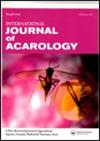寄生虫科线粒体基因组tRNA基因的比较分析
IF 1
3区 农林科学
Q3 ENTOMOLOGY
引用次数: 1
摘要
摘要:本研究采用线粒体基因组测序方法,研究寄生科tRNA基因二级结构。tRNAscan-SE和ARWEN鉴定并推断了时间虫寄生物22个tRNA基因的二级结构,并与已测序的寄生科线粒体基因组中的22个tRNA基因进行了比较。结果表明:寄生蜂科大部分tRNA基因具有典型的三叶草二级结构;折叠过程中发生碱基置换或错配,茎区碱基变异小于环区,具有较高的保守性。相对同义密码子使用(Relative synonymous codon usage, RSCU)分析显示,寄生蜂种tRNA基因的第3个密码子更倾向于使用以a或u结尾的密码子。c -plot分析显示,大部分基因分布在标准曲线下,说明寄生蜂种密码子使用受自然选择压力的影响较大。系统发育分析表明,寄生蜂属单系类群。本研究是对寄生蜂线粒体tRNA基因研究的补充,对了解tRNA基因序列和二级结构在比较基因组学中的重要性具有深远意义,对寄生蜂物种进化的进一步研究具有重要意义。本文章由计算机程序翻译,如有差异,请以英文原文为准。
Comparative analysis of tRNA genes in the mitochondrial genome of Parasitidae (Parasitiformes: Mesostigmata)
ABSTRACT The mitochondrial genome of Parasitus fimetorum was sequenced to study the Parasitidae tRNA gene secondary structure in Parasitiformes. tRNAscan-SE and ARWEN identified and inferred the secondary structures of 22 tRNA genes of Parasitus fimetorum, which were compared to 22 tRNA genes in sequenced Parasitidae mitochondrial genomes. The results showed that most tRNA genes of Parasitidae had a typical cloverleaf secondary structure; the base substitutions or mismatches occurred during the folding process, and the stem region showed less base variation than the loop region, showing high conservation. The base composition showed a clear preference for A + T. Relative synonymous codon usage (RSCU) analysis showed that the third codon of tRNA genes in Parasitidae species preferred to use codons that ended with A or U. ENC-plot analysis showed that most genes were distributed under the standard curve, indicating that codon usage in Parasitidae species was more influenced by natural selection pressure. Phylogenetic analysis showed that Parasitidae is a monophyletic group. This study complements the research on mitochondrial tRNA genes in Parasitidae, which has far-reaching implications for understanding the importance of tRNA gene sequences and secondary structures in comparative genomics and facilitates further studies on the evolution of species in the Parasitidae.
求助全文
通过发布文献求助,成功后即可免费获取论文全文。
去求助
来源期刊
CiteScore
2.20
自引率
9.10%
发文量
60
审稿时长
6-12 weeks
期刊介绍:
The International Journal of Acarology has a global readership and publishes original research and review papers on a wide variety of acarological subjects including:
• mite and tick behavior
• biochemistry
• biology
• control
• ecology
• evolution
• morphology
• physiology
• systematics
• taxonomy (single species descriptions are discouraged unless accompanied by additional new information on ecology, biology, systematics, etc.)
All submitted manuscripts are subject to initial appraisal by the Editor. If the English is not of a quality suitable for reviewers, the manuscript will be returned. If found suitable for further consideration, it will be submitted to peer review by independent, anonymous expert referees. All peer review is single blind.

 求助内容:
求助内容: 应助结果提醒方式:
应助结果提醒方式:


